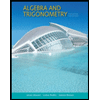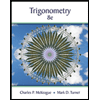Name the quadrant in which the given conditions are satisfied: sin(θ)>0,cos(θ)>0.Given: tan(θ)=−3√3 and sec(θ)>0. Which of the following can be the angle θ?Let P(x,y) denote the point where the terminal side of an angle θ meets the unit circle. If P is in Quadrant IV and x=57, find tan(θ).Let P(x,y) denote the point where the terminal side of an angle θ meets the unit circle. If P is in Quadrant II and y=513, find cot(θ)+csc(θ).
Name the quadrant in which the given conditions are satisfied: sin(θ)>0,cos(θ)>0.Given: tan(θ)=−3√3 and sec(θ)>0. Which of the following can be the angle θ?Let P(x,y) denote the point where the terminal side of an angle θ meets the unit circle. If P is in Quadrant IV and x=57, find tan(θ).Let P(x,y) denote the point where the terminal side of an angle θ meets the unit circle. If P is in Quadrant II and y=513, find cot(θ)+csc(θ).
Mathematics For Machine Technology
8th Edition
ISBN:9781337798310
Author:Peterson, John.
Publisher:Peterson, John.
Chapter73: Achievement Review—section Seven
Section: Chapter Questions
Problem 50AR: Determine the sine, cosine, tangent, cotangent, secant, and cosecant of each of the following...
Related questions
Topic Video
Question
Name the quadrant in which the given conditions are satisfied: sin(θ)>0,cos(θ)>0.
Given: tan(θ)=−3√3 and sec(θ)>0. Which of the following can be the angle θ?
Let P(x,y) denote the point where the terminal side of an angle θ meets the unit circle. If P is in Quadrant IV and x=57, find tan(θ).
Let P(x,y) denote the point where the terminal side of an angle θ meets the unit circle. If P is in Quadrant II and y=513, find cot(θ)+csc(θ).
Expert Solution
This question has been solved!
Explore an expertly crafted, step-by-step solution for a thorough understanding of key concepts.
This is a popular solution!
Trending now
This is a popular solution!
Step by step
Solved in 6 steps with 5 images

Knowledge Booster
Learn more about
Need a deep-dive on the concept behind this application? Look no further. Learn more about this topic, calculus and related others by exploring similar questions and additional content below.Recommended textbooks for you

Mathematics For Machine Technology
Advanced Math
ISBN:
9781337798310
Author:
Peterson, John.
Publisher:
Cengage Learning,

Elementary Geometry for College Students
Geometry
ISBN:
9781285195698
Author:
Daniel C. Alexander, Geralyn M. Koeberlein
Publisher:
Cengage Learning

Elementary Geometry For College Students, 7e
Geometry
ISBN:
9781337614085
Author:
Alexander, Daniel C.; Koeberlein, Geralyn M.
Publisher:
Cengage,

Mathematics For Machine Technology
Advanced Math
ISBN:
9781337798310
Author:
Peterson, John.
Publisher:
Cengage Learning,

Elementary Geometry for College Students
Geometry
ISBN:
9781285195698
Author:
Daniel C. Alexander, Geralyn M. Koeberlein
Publisher:
Cengage Learning

Elementary Geometry For College Students, 7e
Geometry
ISBN:
9781337614085
Author:
Alexander, Daniel C.; Koeberlein, Geralyn M.
Publisher:
Cengage,

Algebra & Trigonometry with Analytic Geometry
Algebra
ISBN:
9781133382119
Author:
Swokowski
Publisher:
Cengage

Algebra and Trigonometry (MindTap Course List)
Algebra
ISBN:
9781305071742
Author:
James Stewart, Lothar Redlin, Saleem Watson
Publisher:
Cengage Learning

Trigonometry (MindTap Course List)
Trigonometry
ISBN:
9781305652224
Author:
Charles P. McKeague, Mark D. Turner
Publisher:
Cengage Learning